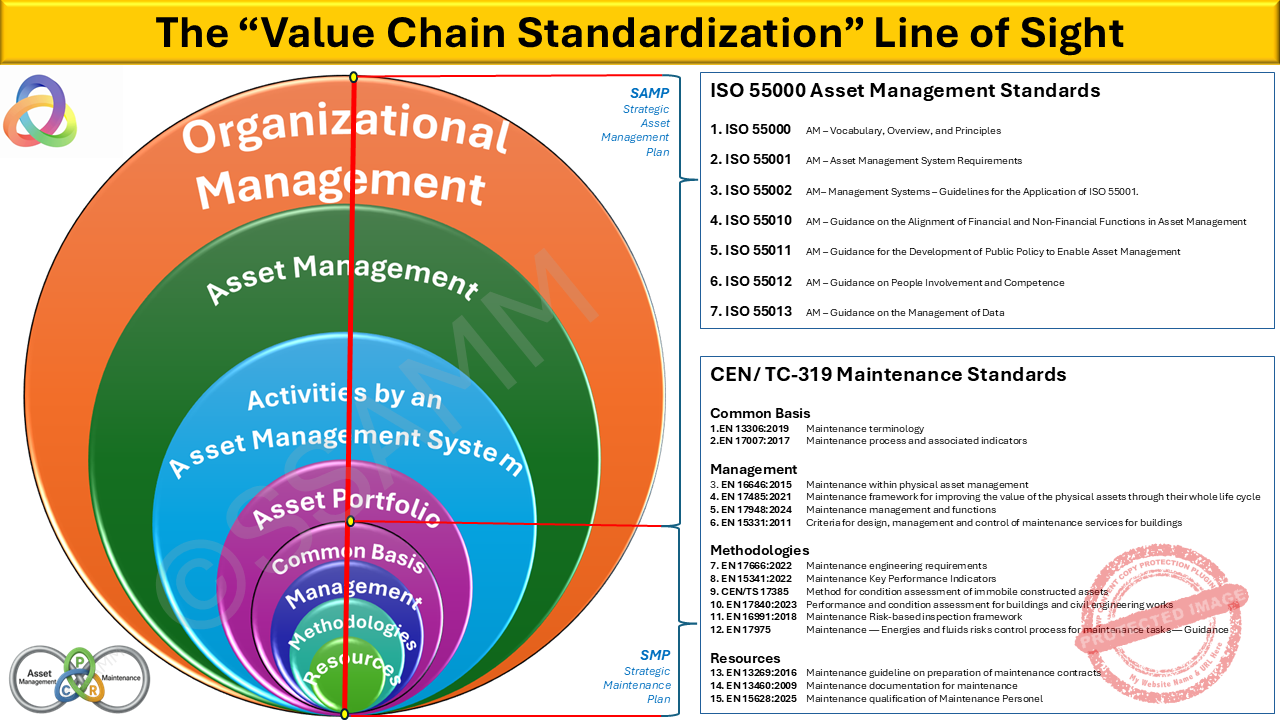The Value Chain Standardization Line of Sight (VCS Line of Sight)
The Value Chain Standardization Line of Sight – abbreviated as the VCS Line of Sight – is introduced in this book as a way to address precisely that gap.
The VCS Line of Sight is not a new standard. It is a structuring perspective that arranges the ISO 55000:2024 family and the CEN/TC 319 standards into one layered view of the Asset & Maintenance Management (A&MM) value chain. It shows, in a single visual and conceptual model, how organisational management, the Asset Management System (AMS), the Strategic Maintenance Policy (SMP) and the maintenance landscape relate to one another. From the top, it starts with organisational objectives, public value and risk appetite; from there it passes through the AMS and SMP into maintenance processes, methodologies and resources, and then back again via data, indicators and assurance. Along this axis, decisions and information can be traced from strategy to execution and back.
A central contribution of the VCS Line of Sight is the explicit distinction between vertical and horizontal line of sight. Vertical line of sight concerns the traceability of decisions and information across layers: from policy, SAMP and SMP down to maintenance programmes and work orders, and back up through KPIs, risk evaluations and feedback. Horizontal line of sight concerns the coherence between functions within the same layer: at the top between executive management, finance, risk and operations; at the AMS layer between planning, portfolio, information and assurance; and at the maintenance layer between engineering, planning, execution, contracting and competence management. Only when vertical traceability and horizontal coherence are both in place can an organisation credibly claim a standardised, explainable value chain.
Within this framework, several SSAMM concepts find their natural place. The Strategic Maintenance Policy (SMP) is positioned as a pivotal node on the line of sight: it translates asset management objectives from the SAMP into maintenance principles, concepts and programmes and anchors maintenance within the AMS. The P–C–R Trefoil provides the recurring decision logic for balancing performance (P), cost (C) and risk (R) at multiple levels along the chain. The A&MM Lemniscate portrays the dynamic interaction between Asset Management and Maintenance over time, while the Maintenance Framework organises the CEN/TC 319 standards (EN 13306, EN 17007, EN 17485, EN 17666, EN 15628 and related norms) into a coherent maintenance architecture. The VCS Line of Sight acts as the structural spine that connects these elements into one integrated picture.
In the lower half of the model, the maintenance value chain is further articulated into four layers: Common Basis, Management, Methodologies and Resources. These layers represent, respectively, the shared terminology and concepts, the governance and processes, the technical and analytical methods, and the people, tools and contracts through which work is performed on real assets. In the upper half, the ISO 55000:2024 architecture provides the structure for organisational governance, the AMS and the strategic translation of value into asset-related objectives. By placing both halves in one VCS Line of Sight, standardisation is no longer a set of documents on the shelf, but an architecture that explains who does what, on which basis and with which decision logic.
For the reader of this SAM book, the importance of the VCS Line of Sight lies in three main insights. First, value is a chain outcome: it is produced by coordinated decisions and actions across multiple layers and roles, not at a single point in the organisation. Second, standards themselves are assets: their value is only realised when they are selected, combined and governed as part of a coherent architecture rather than used as isolated checklists. Third, governance of maintenance is central: the SMP, the maintenance landscape and the P–C–R decision logic must be visibly connected to the AMS and to the ISO and CEN/TC 319 frameworks if line-of-sight claims are to be credible.
This chapter therefore presents the VCS Line of Sight as both a diagnostic tool and a design guide. It can be used to reveal where standards are currently applied, where gaps and overlaps exist, and how vertical and horizontal line of sight can be strengthened. It can also support the design of an Asset & Maintenance Management architecture that is traceable, learnable and ready for Industry 5.0: one in which the lemniscate’s dynamics are supported by a clear structural spine. By the end of this chapter, you should be able to read your own organisation’s value chain through the lens of Value Chain Standardization and recognise why a clear VCS Line of Sight is a prerequisite for truly sustainable Asset Management.


